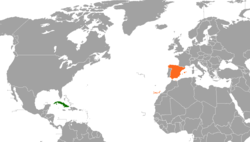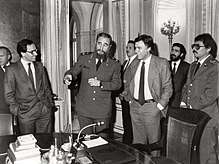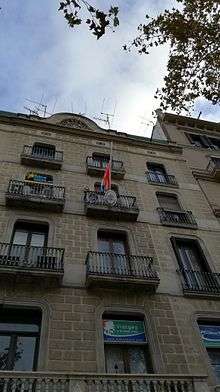Cuba–Spain relations
Cuba–Spain relations refer to the bilateral relations between the Republic of Cuba and the Kingdom of Spain. Relations date back more than five centuries. Cuba had been a colony from 1492 until 1898 when the United States took over the territory in the Spanish–American War, and then Cuba became an independent country. Many Cubans have ancestry dating back from Spain. Many Spaniards escaped the first Spanish Civil War and went to Cuba, and other countries, around 1820-1825.
 | |
Cuba |
Spain |
|---|---|
History
Spanish colonization
The first contact between Spain and the island of Cuba was in October 1492 when explorer Christopher Columbus arrived to Cuba. The first permanent Spanish settlement on the island began in 1511 when Spanish conquistador Diego Velázquez de Cuéllar established a settlement in Baracoa.[1] Cuba would become the launching point for further Spanish exploration on the American continent. By 1521, Cuba became part of the Spanish Empire and was governed from the Viceroyalty of New Spain based in Mexico City.[2]
During Spanish administration of Cuba, the island became a substantial producer of sugarcane and in order to meet global demands, Spain began to import slaves from Africa to work in Cuba.[1] This made the economy of Cuba highly volatile to world prices as its economy depended on one single crop.[2]
Independence

By 1868, many countries in Latin America had obtained independence from Spain. In October 1868, Cuban planter and sugar mill owner Carlos Manuel de Céspedes and his followers proclaimed independence for Cuba. This proclamation led to the Ten Years' War with Spain and ended in the independence movement defeat in 1878.[1] In August 1879, a second struggle ensued known as the Little War and lasted until September 1880 with the independence movement defeat once more.
In February 1895, a new independence struggle movement began and is known as the "Cuban War of Independence" and was led by Cuban Poet José Martí who died in May 1895 at the Battle of Dos Ríos. The war lasted until 1898 when Cuban Patriots seeking independence asked the United States for help, which deployed forces to the island. That same year, American naval ship, USS Maine (ACR-1) exploded and sank in the Havana Harbor and resulted in the United States blaming the incident on Spain. This resulted in the Spanish–American War which began in April 1898 until August 1898. At the end of the war, the United States came out as the victors in the war and obtained Cuba as a possession and it resulted in the defeat and collapse of the Spanish Empire.[1] In 1902, Cuba seceded from American governance and became an independent nation.
Post independence

The first Spanish consul general, José Felipe Sagrario arrived to Cuba in July 1899[3] during the US occupation. Spanish consul general Joaquín María Torroja became the chargé d'affaires after the formal establishment of the Cuban Republic in May 1902.[4] In 1902, Cuba and Spain established diplomatic relations.[2] Between 1902 and 1928, Cuba would receive more than 1.2 million Spanish immigrants.[5]
During the Spanish Civil War (1936-1939), the Cuban government showed a neutral stance with inclinations to the Spanish Republican faction. In 1937, Cuban President Fulgencio Batista's position favored the Franco regime, reflecting his changing relations with the United States.[5]
In spite of Franco's anticommunism, Cuba and Spain held diplomatic relations after Fidel Castro came into power and became Prime Minister of Cuba in 1959.[6] In 1960, Prime Minister Castro expelled the Spanish ambassador Juan Pablo de Lojendio e Irure[7] after an argument on TV. The Spanish ambassadorship in Cuba would remain vacant for the next 15 years, however, diplomatic relations between both nations continued at the level of chargé d'affaires.[8]
During Franco’s administration in Spain; Prime Minister Castro welcomed Spanish Republicans, such as the Communist Dolores Ibárruri, General Enrique Líster and Alberto Bayo, who had taught guerrilla warfare to the Cuban revolutionaries in Mexico.[9] When the United States decreed an embargo against Cuba in 1960 and 1962, its Latin American and European allies followed suit, however, Francisco Franco did not place an embargo on Cuba. American pressure against the Spanish embargo breach was deflected by the renegotiation of the American military bases in Spain in 1963.
After Franco's death, Cuba decreed three days of mourning.[9] In 1974, ambassadors between Cuba and Spain were appointed. After the Spanish transition to democracy, Spanish Prime Minister Adolfo Suárez visited Cuba in 1978.[10]
In July 1992, Fidel Castro visited Spain for the first time to attend the 2nd Ibero-American Summit in Madrid. During his time in Spain, Castro also paid a visit to the town of Láncara in Galicia where his father was born. Castro returned to Spain in 1998 to meet with Spanish Prime Minister José María Aznar.[11]
In November 1999, Spanish King Juan Carlos I paid an official visit to Cuba and to attend the 9th Ibero-American Summit being held in Havana. He returned to Cuba in 2016 to attend Fidel Castro’s funeral.[12]
In 2018, Spanish Prime Minister, Pedro Sánchez made an official visit to Cuba. While in Cuba, Prime Minister Sánchez met with Cuban President Miguel Díaz-Canel and both leaders signed a memorandum for the establishment of permanent political contacts through annual meetings.[13] In November 2019, King Felipe VI of Spain paid a state visit to Cuba, the first by a Spanish King.[14]
Bilateral relations
Over the years, both nations have signed numerous bilateral agreements, such as an Extradition Treaty (1905); Scientific and Technical Agreement (1978); Trade Agreement (1982); Cultural and Education Cooperation Agreement (1982); Promotion and Protection of Investments Agreement (1994); Double-Taxation Avoidance Agreement (1999) and an Air Transportation Agreement (2005), among others.[2]
Transportation
There are direct flights between Cuba and Spain through the following airlines: Air Europa, Cubana de Aviación, Evelop Airlines, Iberia and Plus Ultra Líneas Aéreas.
Trade
In 2017, trade between Cuba and Spain totaled €1.3 billion Euros.[2] Cuba’s main exports to Spain include shrimp, rum, tobacco, and sugar. Spain’s main exports to Cuba include machinery, food, automobile parts, and electrical equipment. Spain is the largest foreign investor in Cuba from the European Union; Cuba is Spain’s 42nd largest trading partner globally and 4th largest from Latin America (after Mexico, Brazil and Chile).[2]
Resident diplomatic missions
- Cuba has an embassy in Madrid and consulates-general in Barcelona, Las Palmas, Santiago de Compostela and Seville.[15]
- Spain has an embassy in Havana.[16]
.jpg) Embassy of Spain in Havana
Embassy of Spain in Havana Consulate-General of Cuba in Barcelona
Consulate-General of Cuba in Barcelona- Consulate-General of Cuba in Santiago de Compostela
See also
| Wikimedia Commons has media related to Relations of Cuba and Spain. |
References
- Encyclopædia Britannica: Cuba
- Spanish Ministry of Foreign Affairs: Cuba (in Spanish)
- Amores & Otero 2001, pp. 83-84.
- Amores & Otero 2001, p. 87.
- Pardo Sanz 1995.
- Hosoda 2008, pp. 17-18.
- Hosoda 2008, p. 17.
- Sotelo 2000, p. 95.
- (in Spanish) Franco y Fidel, enemigos cordiales, F. Javier Herrero, 5 June 2014, El País.
- Sotelo 2000, p. 97.
- Dos visitas oficiales y una queimada con Fraga (in Spanish)
- Don Juan Carlos se despide de La Habana con el deseo de que "Cuba se abra a Cuba" (in Spanish)
- España y Cuba pactan un contacto anual en el que hablarán de derechos humanos (in Spanish)
- El rey Felipe VI afirmó en Cuba el valor de la democracia (in Spanish)
- Embassy of Cuba in Madrid (in Spanish)
- Embassy of Spain in Havana (in Spanish)
- Amores, Juan B.; Otero, Hilda (2001). Las primeras relaciones diplomáticas entre España y Cuba después de 1898 (PDF). Ibero-Americana Pragensia (in Spanish). Supplementum 9. Praga: Nakladatelství Karolinum. pp. 83–98. ISSN 0536-2520.
- Bayo, Francesc (2006). Las relaciones políticas entre España y Cuba. Continuidad histórica y ajustes frecuentes (PDF). Documentos CIDOB (in Spanish). Barcelona: CIDOB Edicions. ISSN 1697-7688.
- García Álvarez, Alejandro; Naranjo Orovio, Consuelo. Cubanos y españoles después del 98: de la confrontación a la convivencia pacífica. Revista de Indias (in Spanish). Consejo Superior de Investigaciones Científicas. pp. 101–129.
- Hosoda, Haruko (2008). The Franco regime’s contradiction: Its foreign policy toward Cuba (PDF). Waseda Global Forum. pp. 15-24. Archived from the original (PDF) on 2015-09-10. Retrieved 2016-11-27.
- Pardo Sanz, Rosa María (1995). Antifascismo en América Latina: España, Cuba y Estados Unidos durante la Segunda Guerra Mundial. Estudios Interdisciplinares de América Latina y el Caribe (in Spanish). 6. Tel Aviv University.
- Roy, Joaquín (1988). Las relaciones actuales entre España y Cuba. Afers internacionals (in Spanish). pp. 5–19.
- Roy, Joaquín (1999). La siempre fiel: Un siglo de relaciones hispanocubanas (1898-1998) (in Spanish). Madrid: Instituto Universitario de Desarrollo y Cooperación; Los Libros de la Catarata. ISBN 84-8319-039-7. Retrieved 2016-11-27.
- Sotelo, Ignacio (2000). Notas sobre la política española en Cuba (PDF). Revista: Encuentro de la Cultura Cubana (in Spanish). Madrid: Asociación Encuentro de la Cultura Cubana. pp. 89–105. ISSN 1136-6389.
- Ucelay Da Cal, Enric (1997). Cuba y el despertar de los nacionalismos en la España peninsular. Studia historica. Historia contemporánea (in Spanish). 15. Salamanca: Universidad de Salamanca. pp. 151–192. ISSN 0213-2087.

.svg.png)